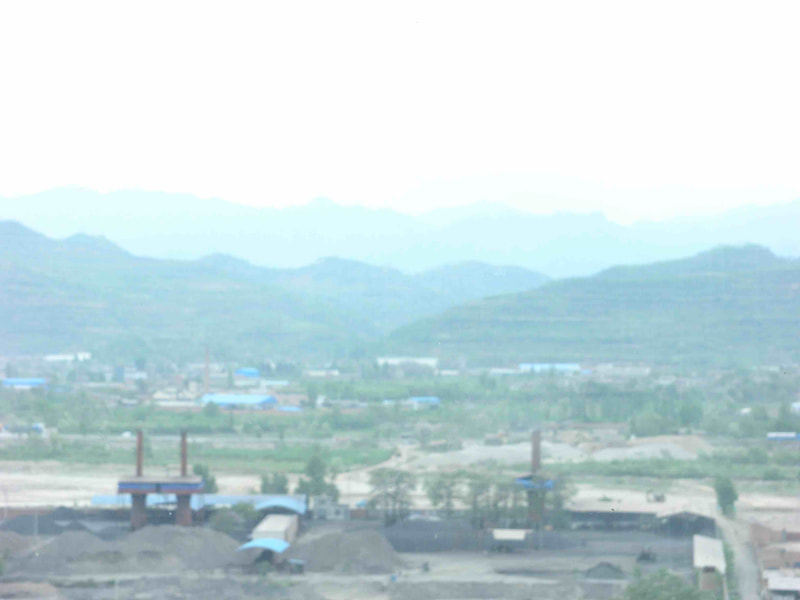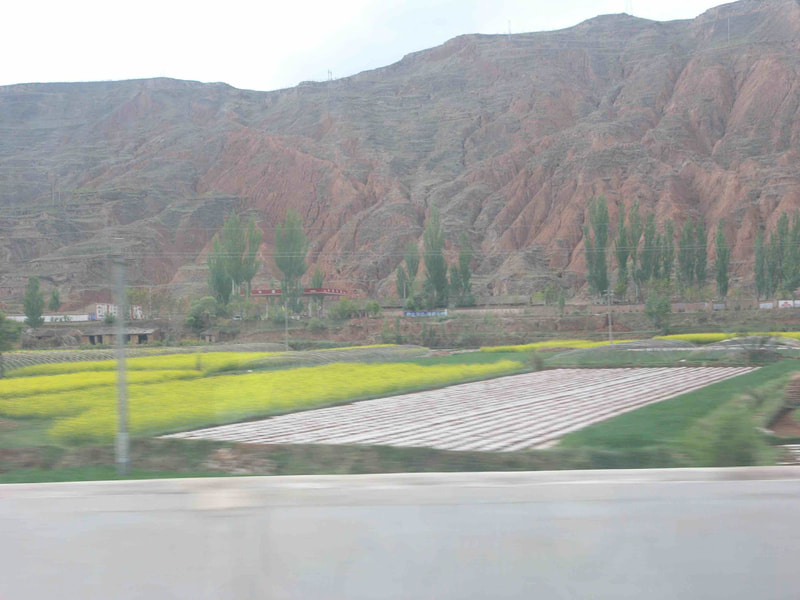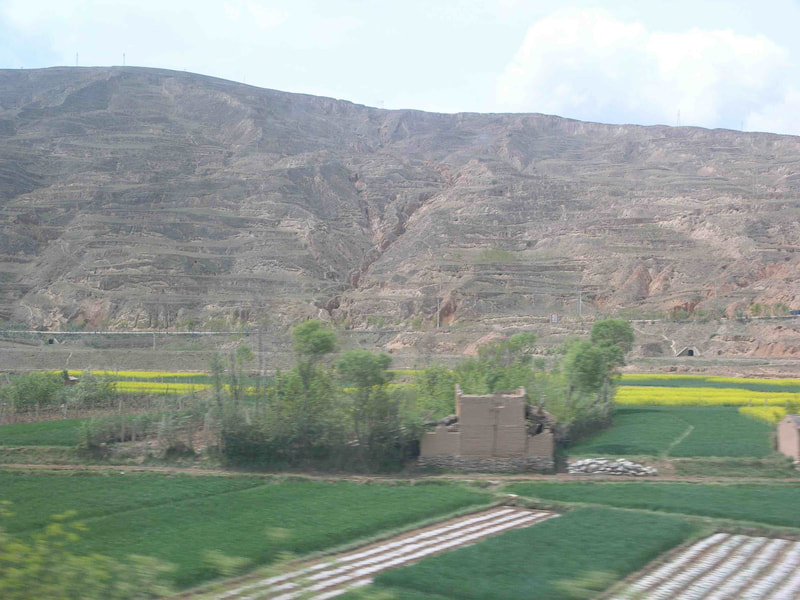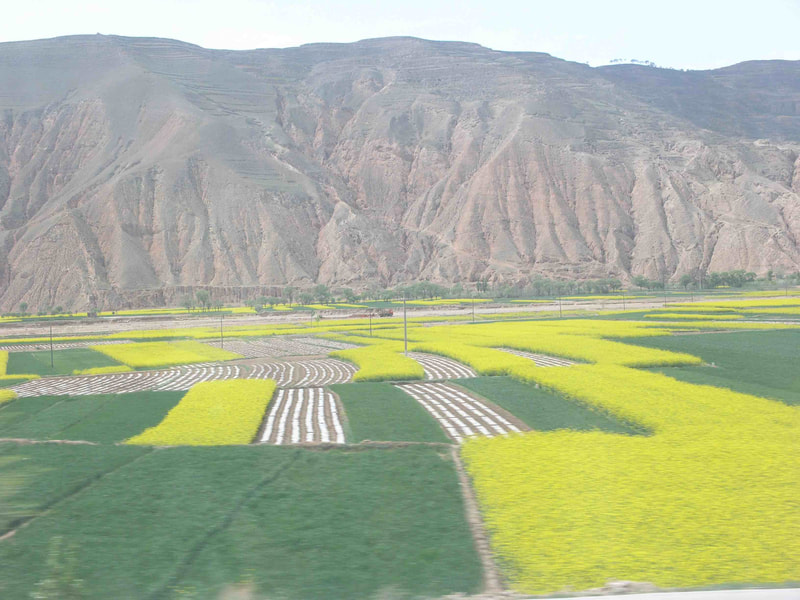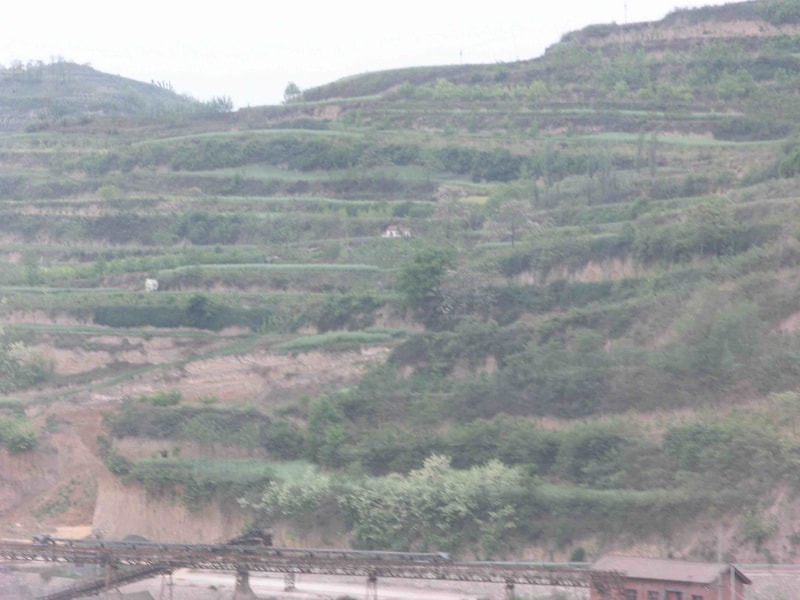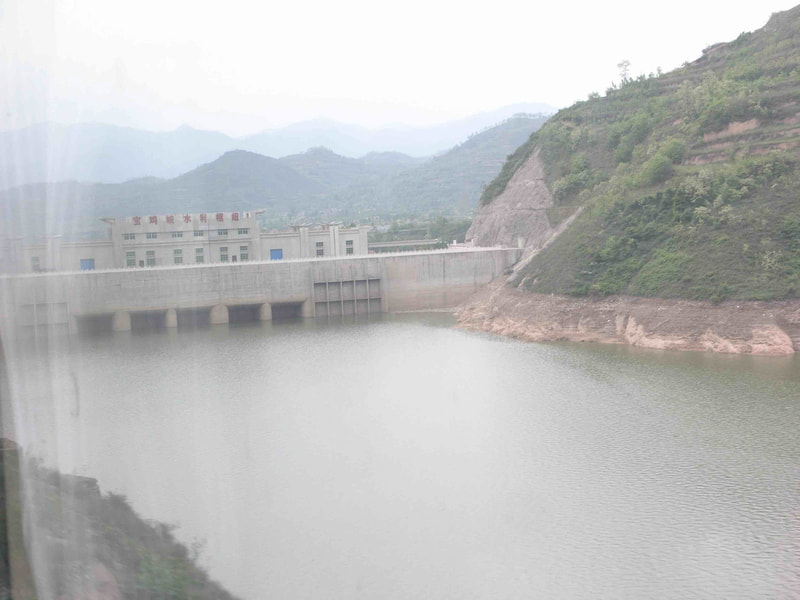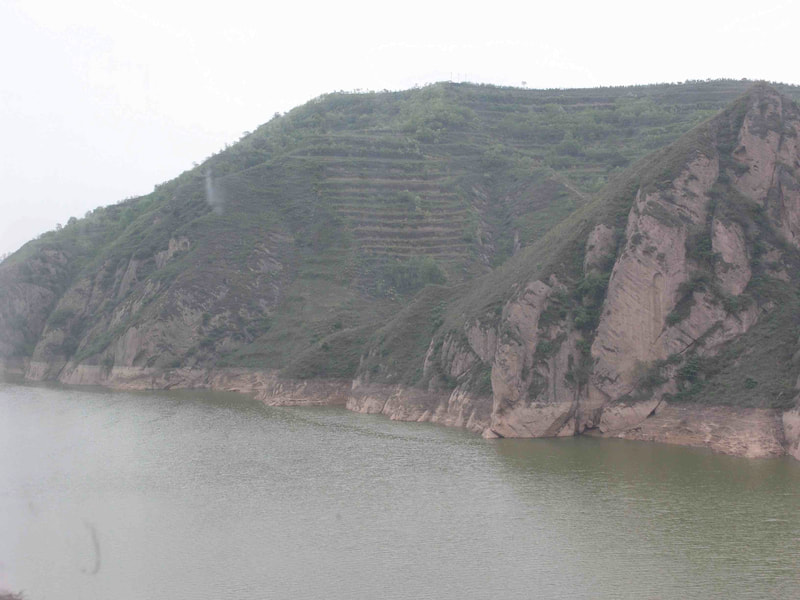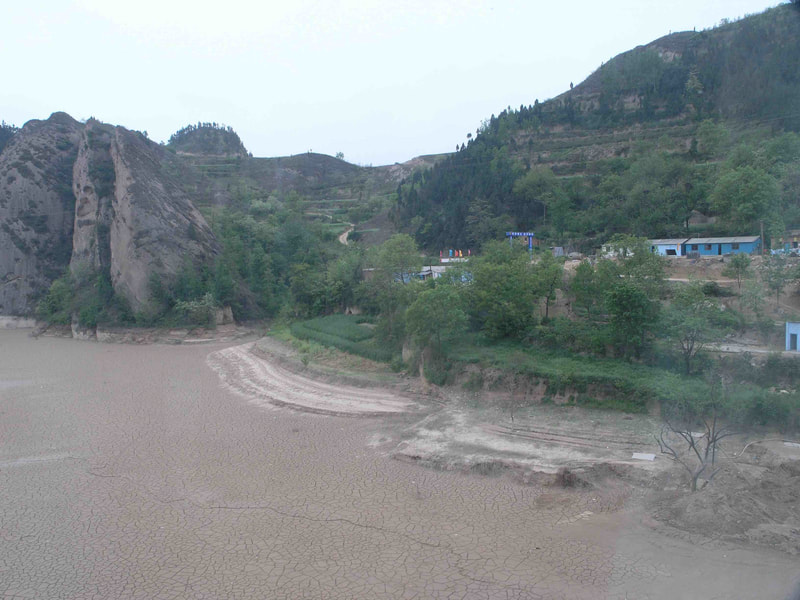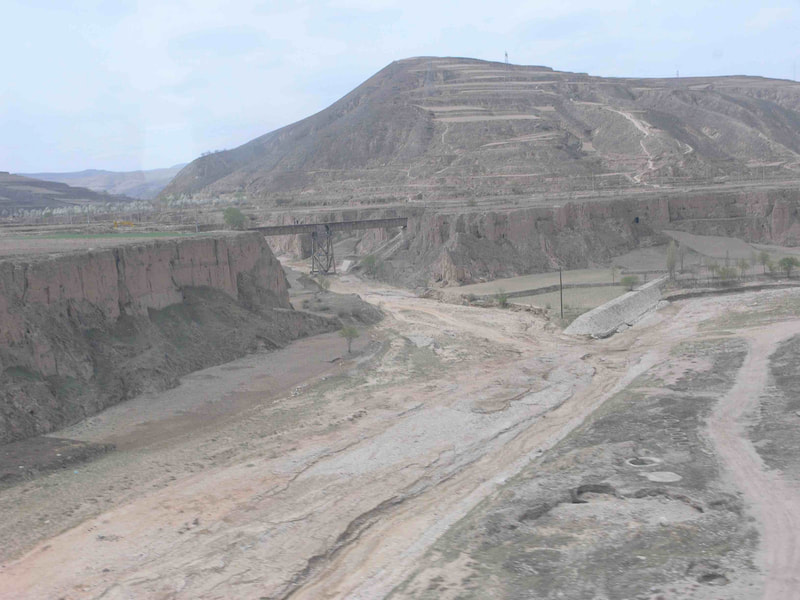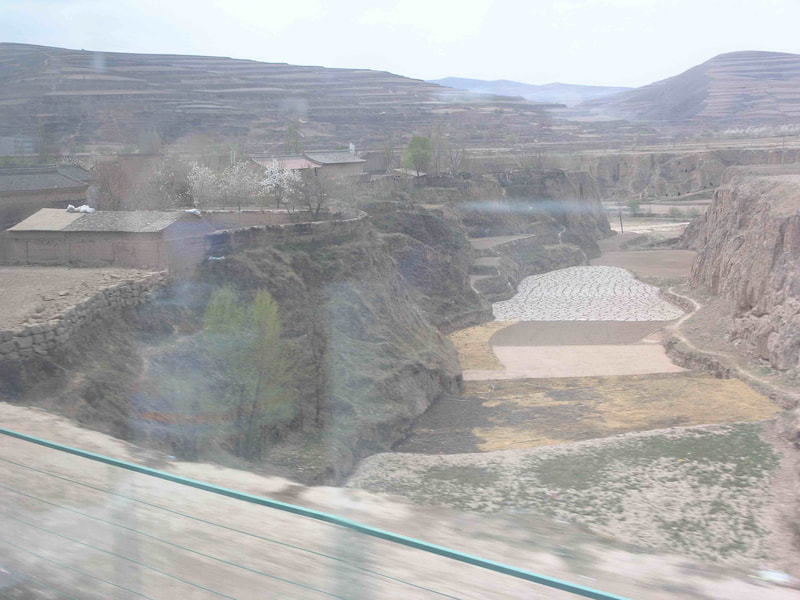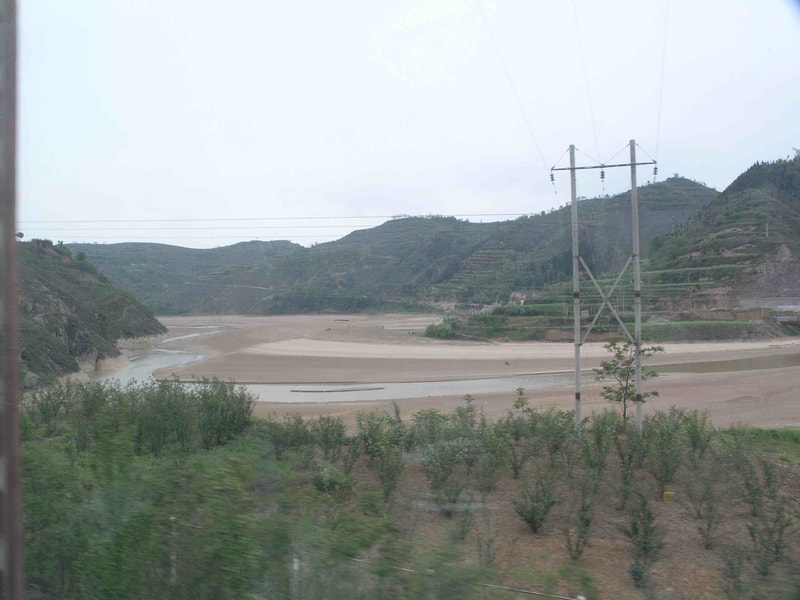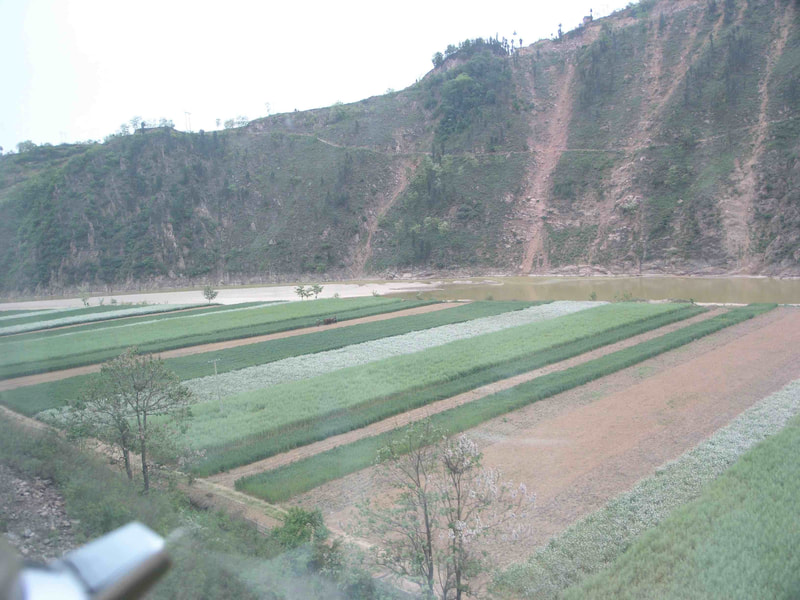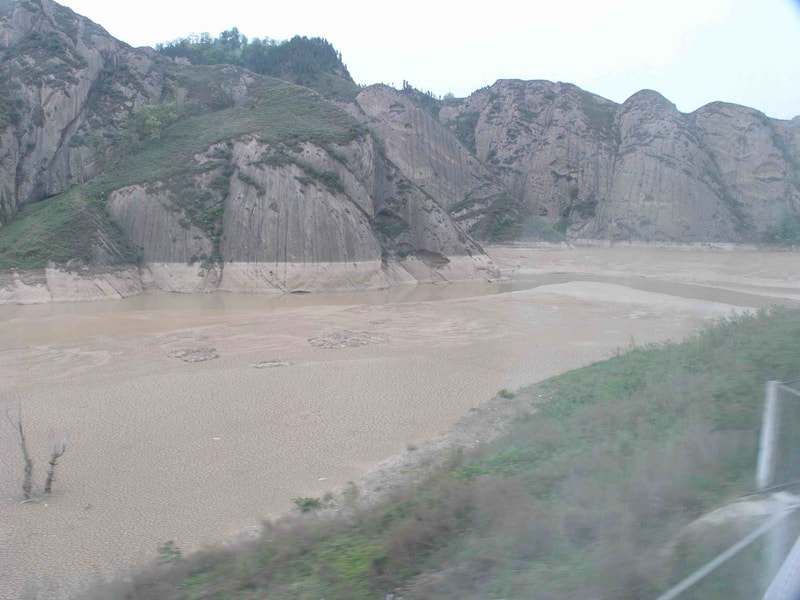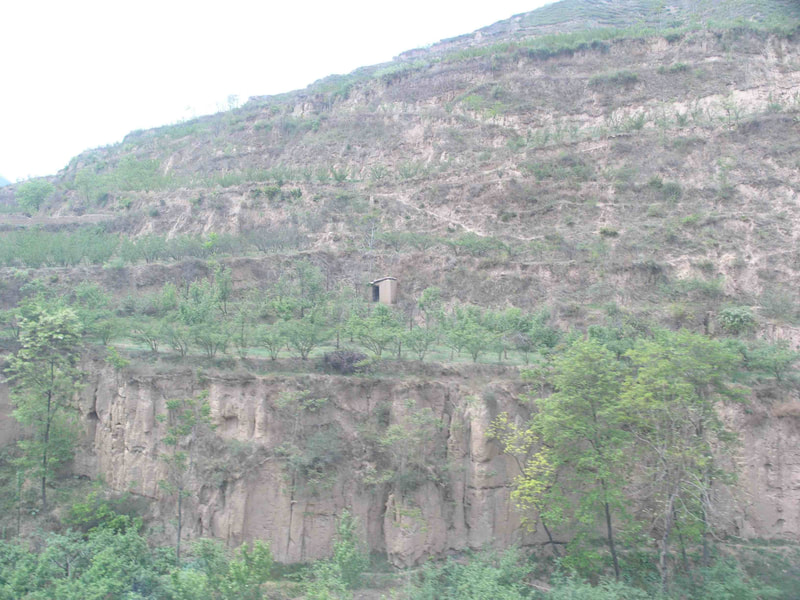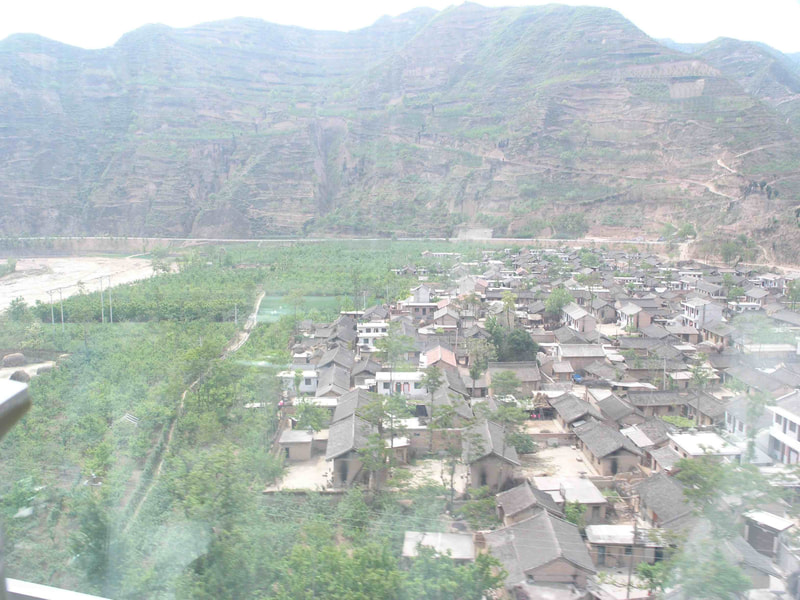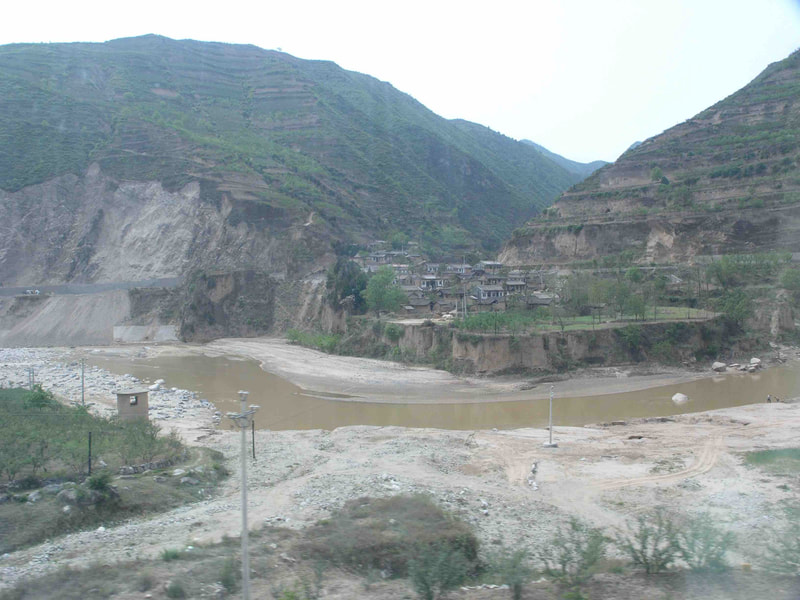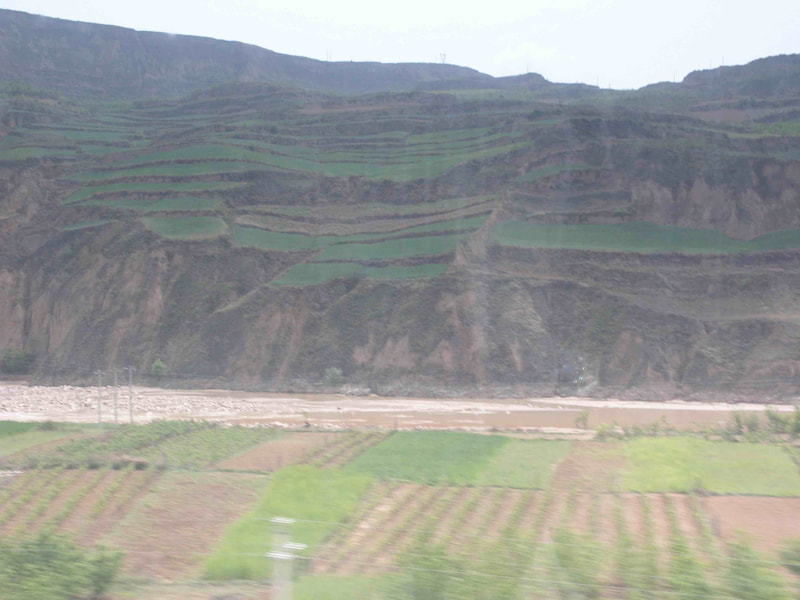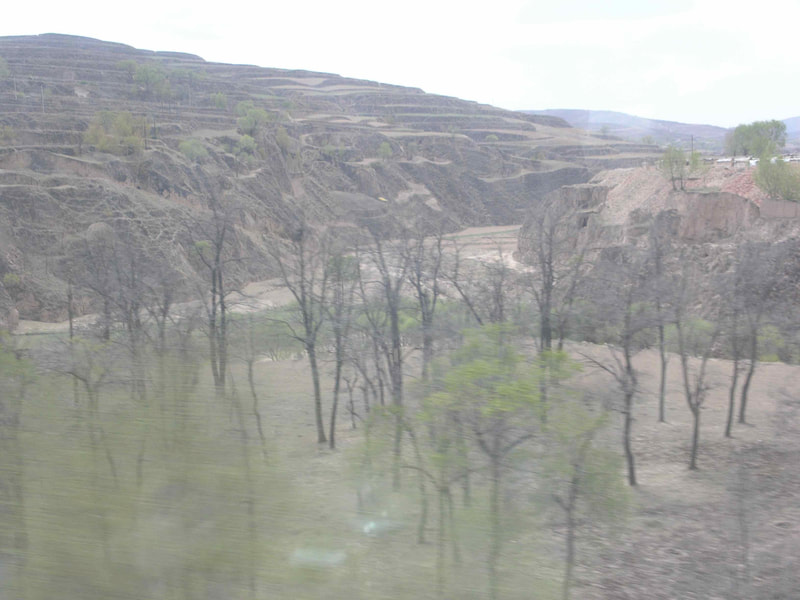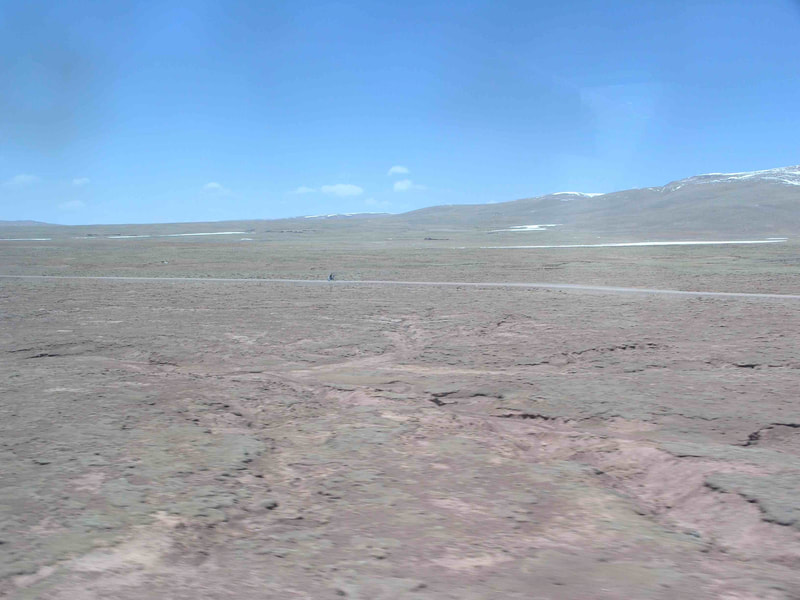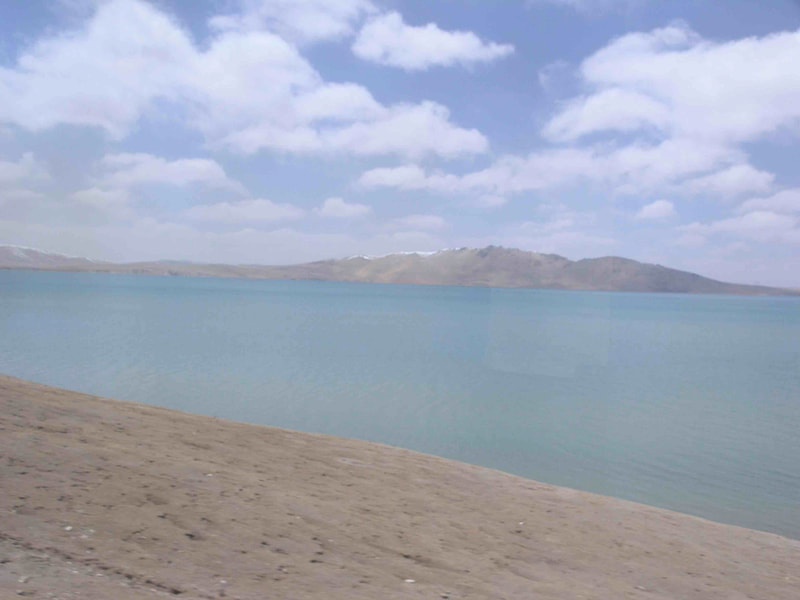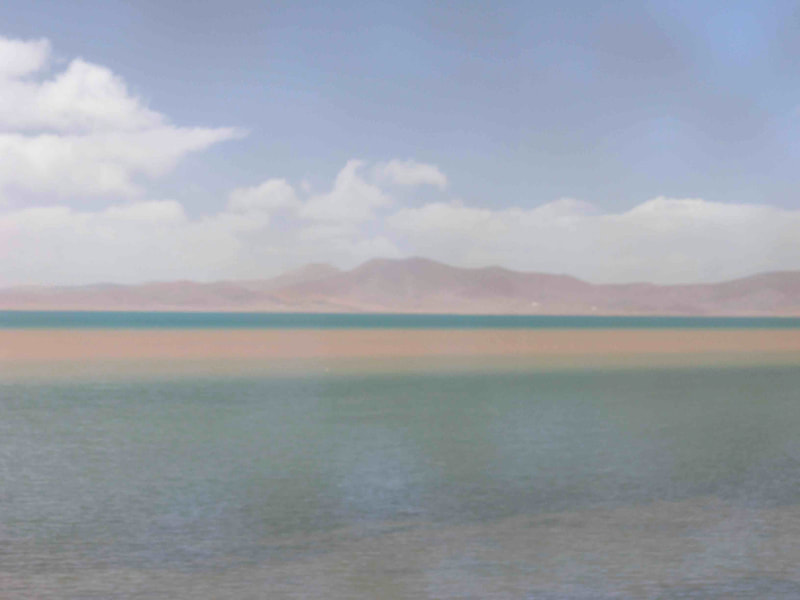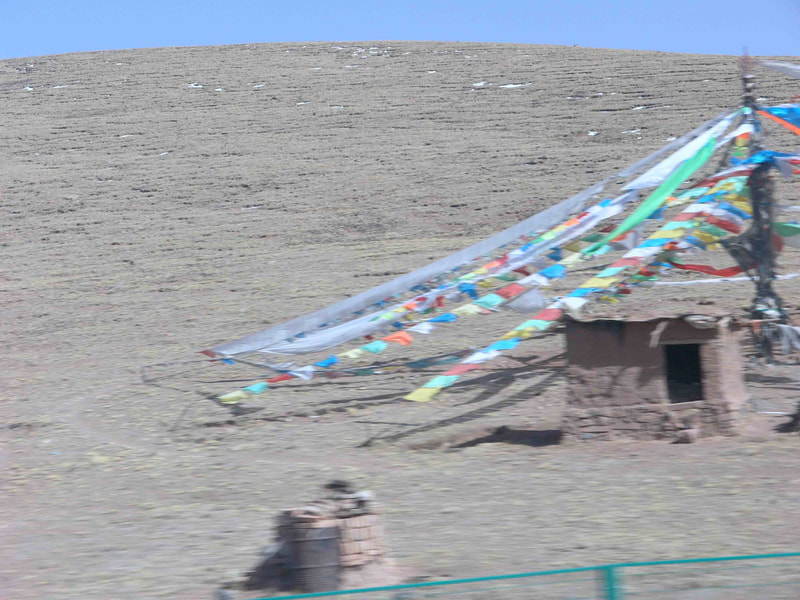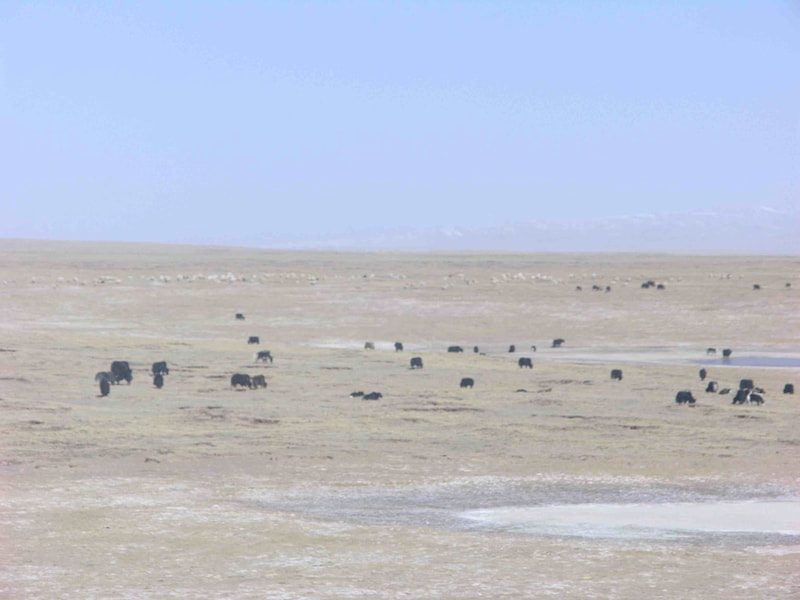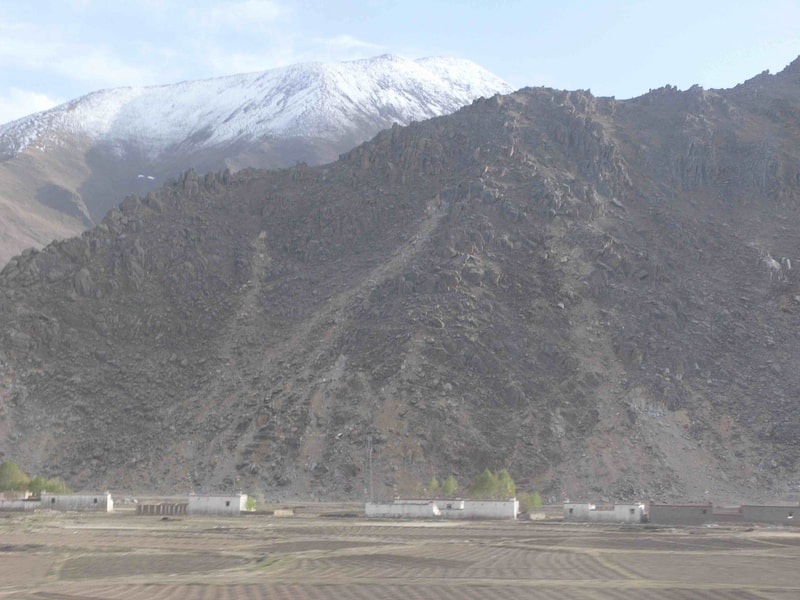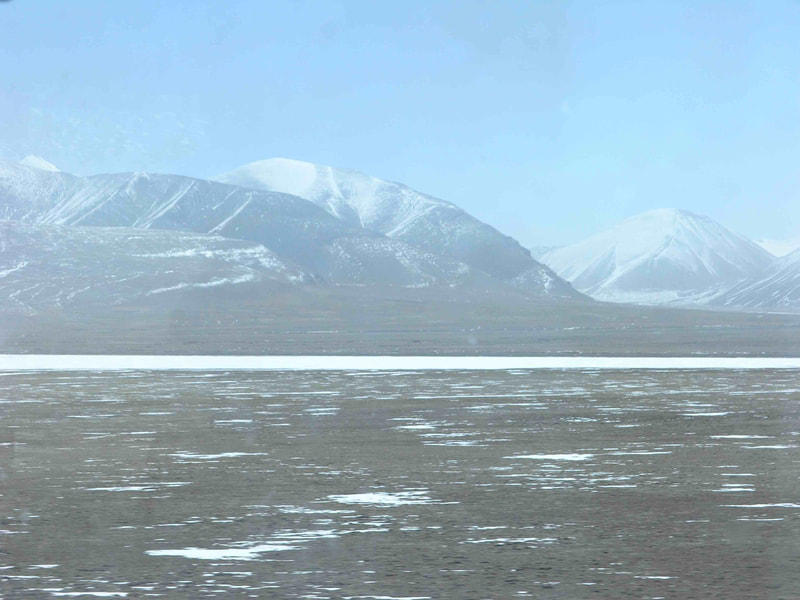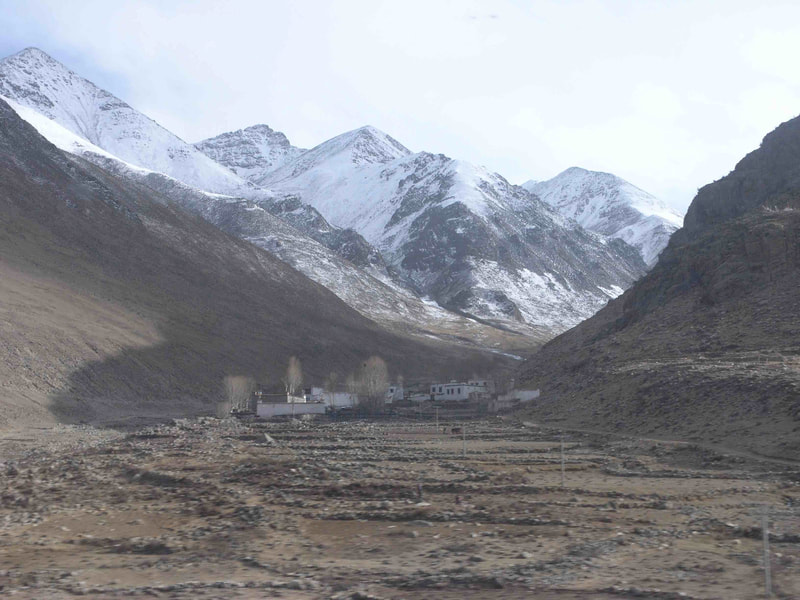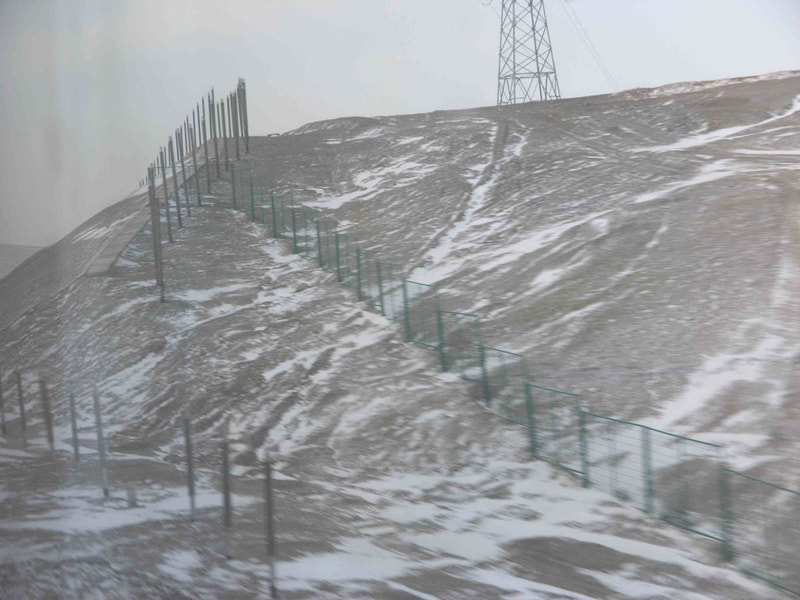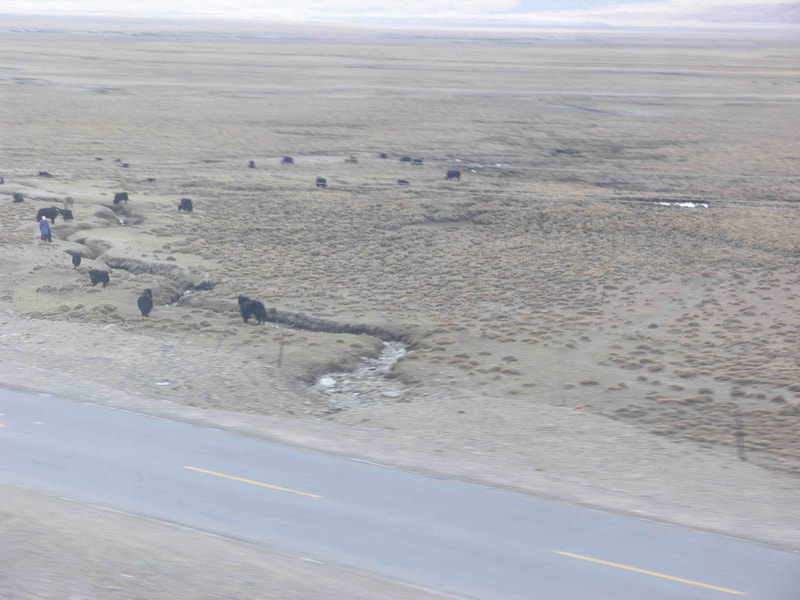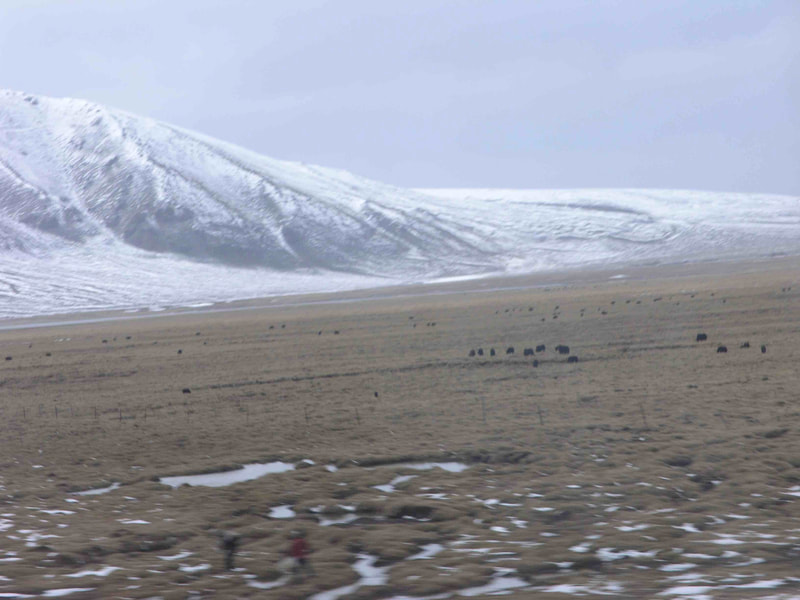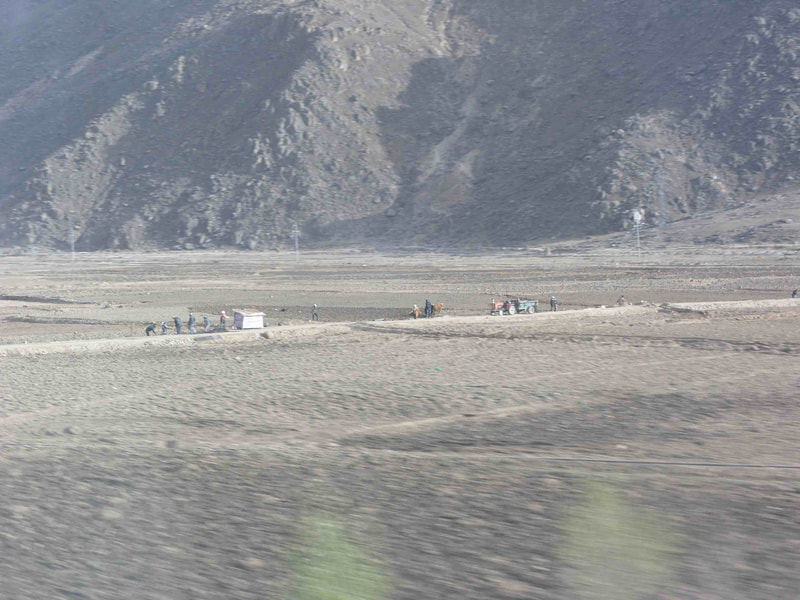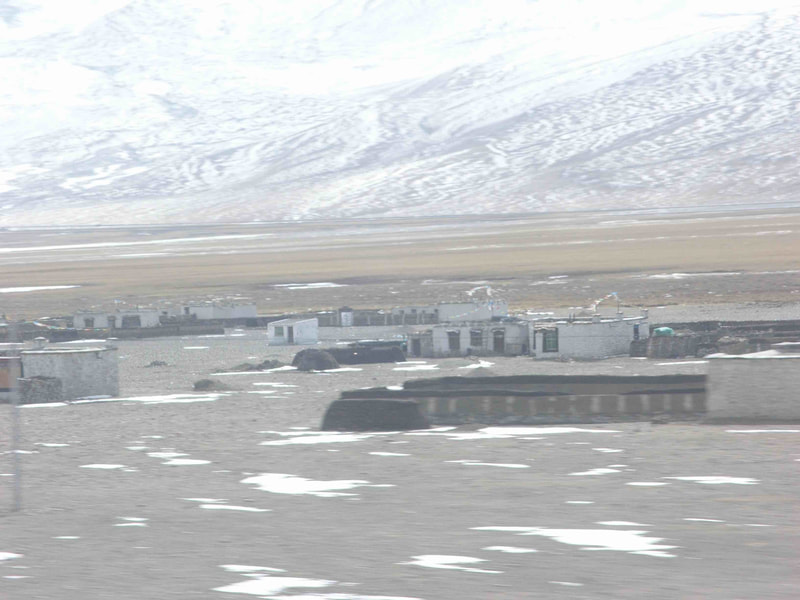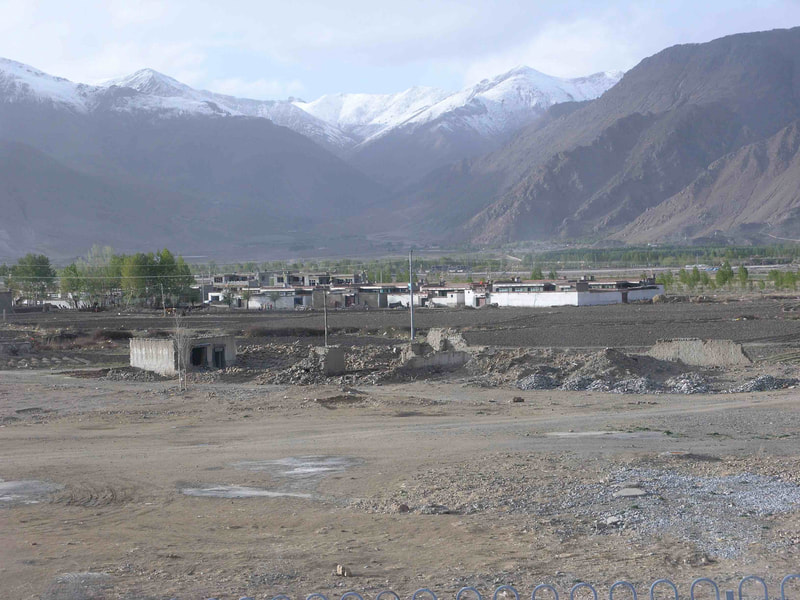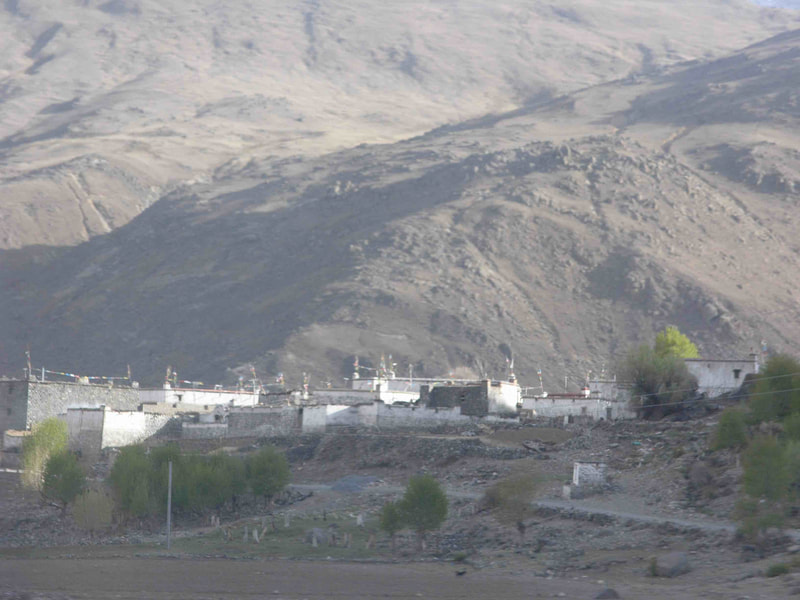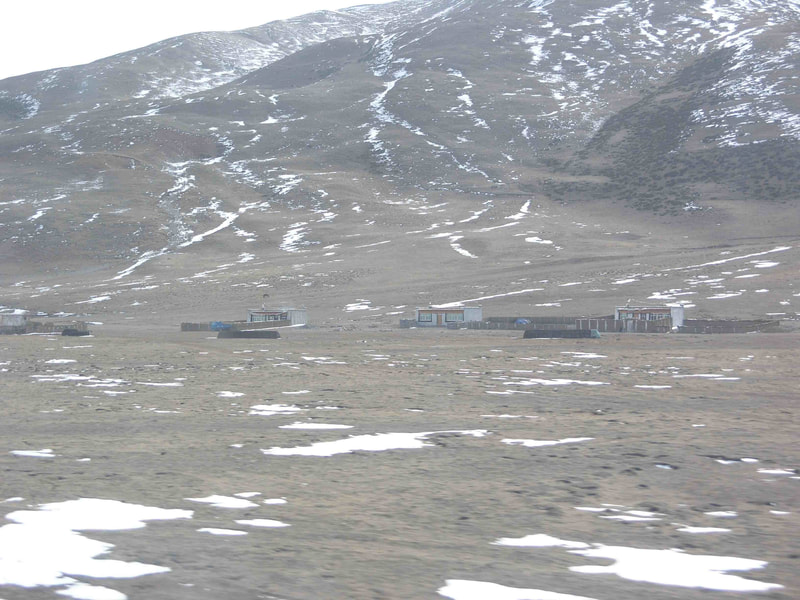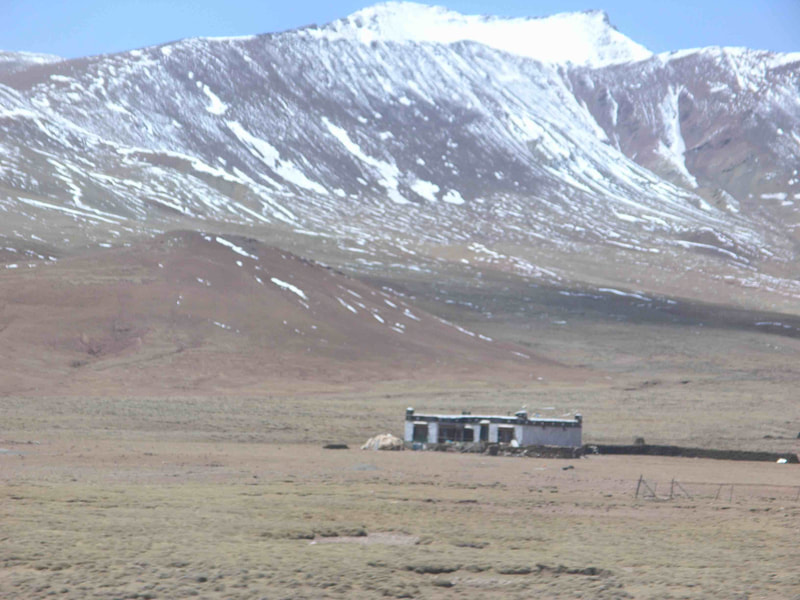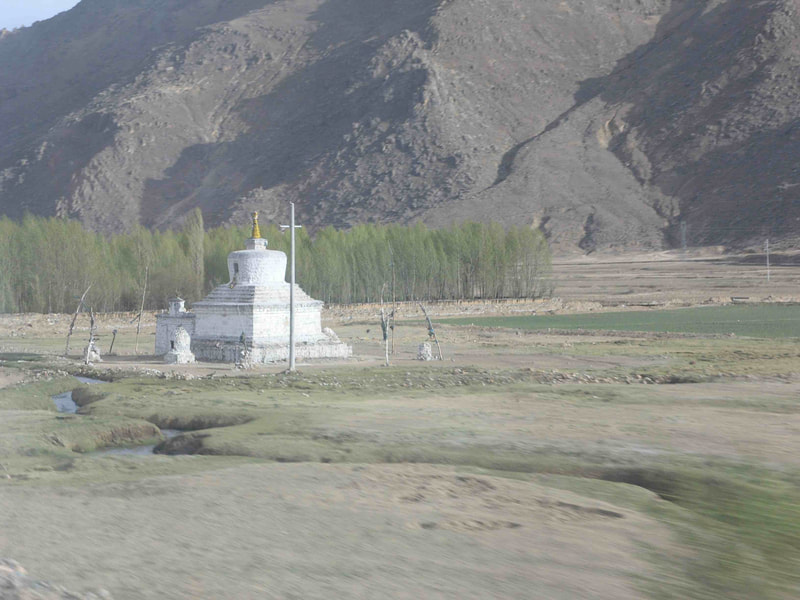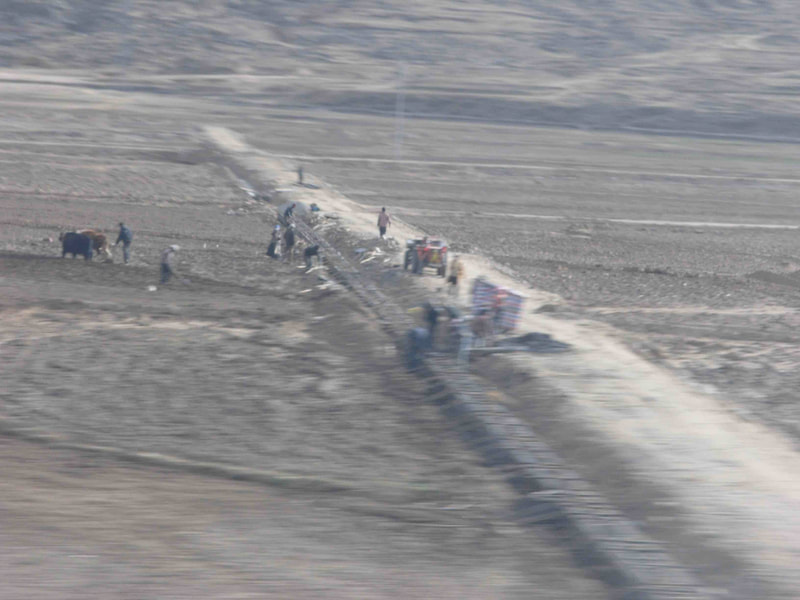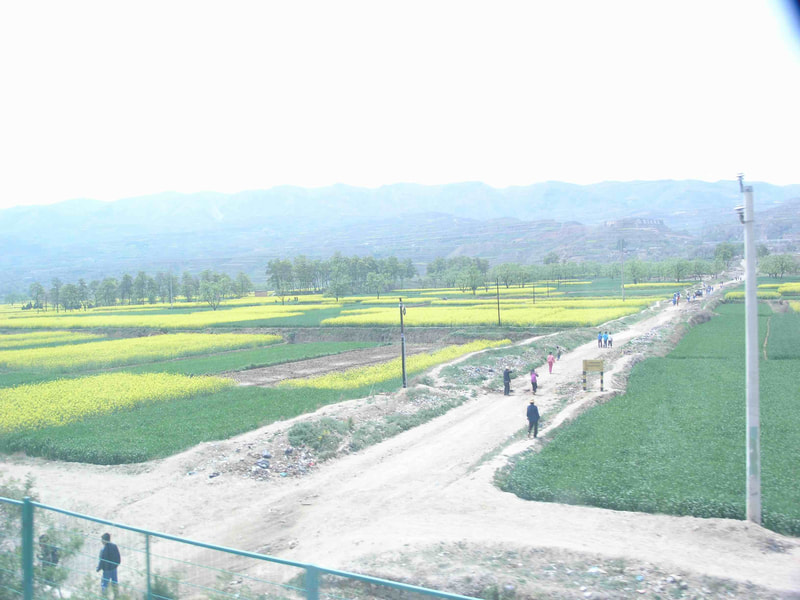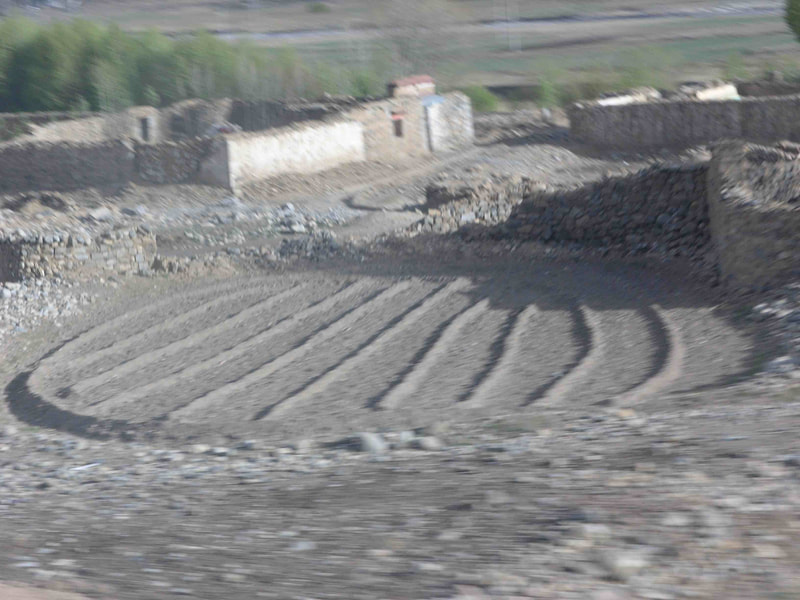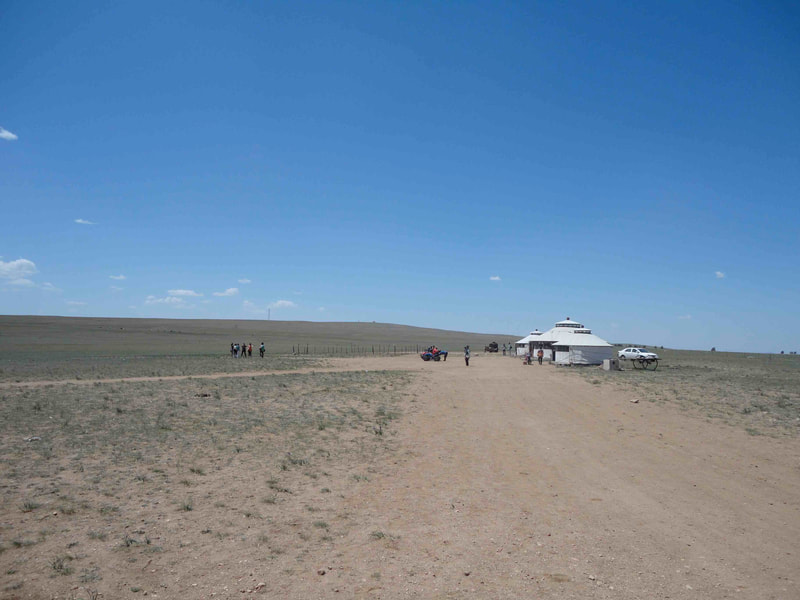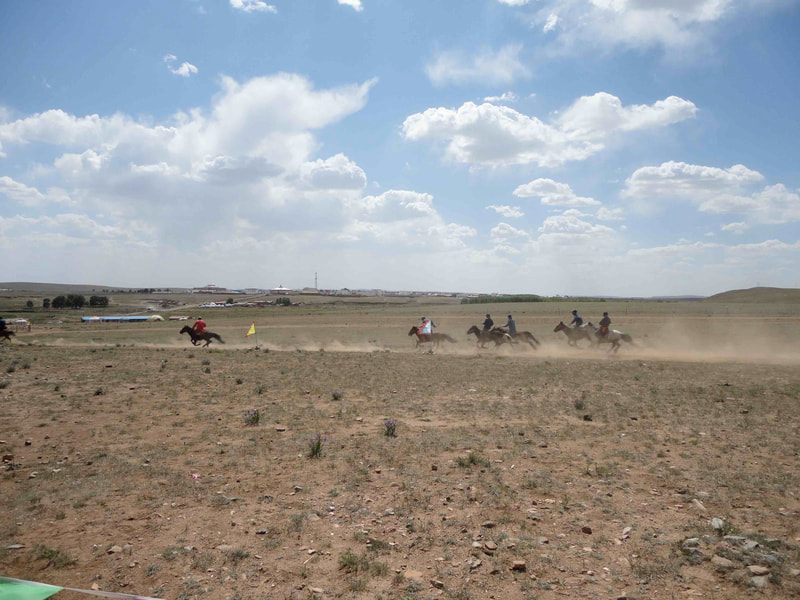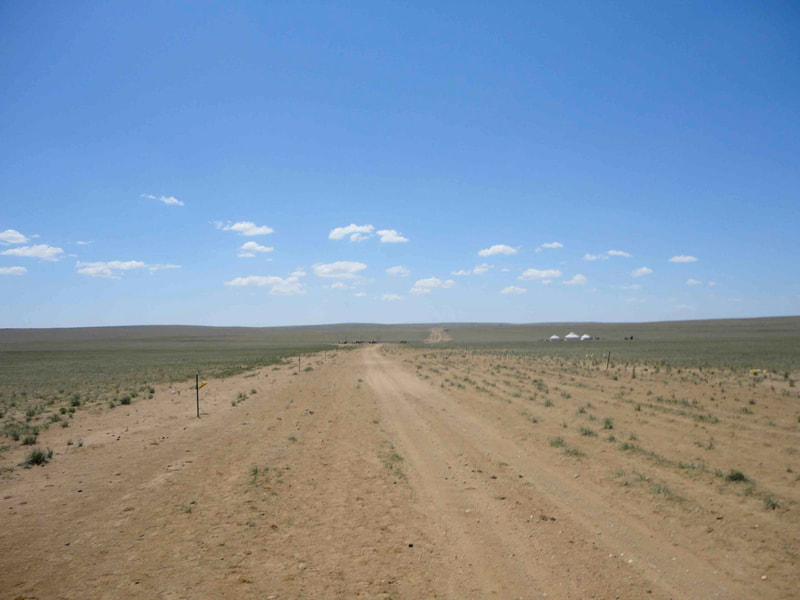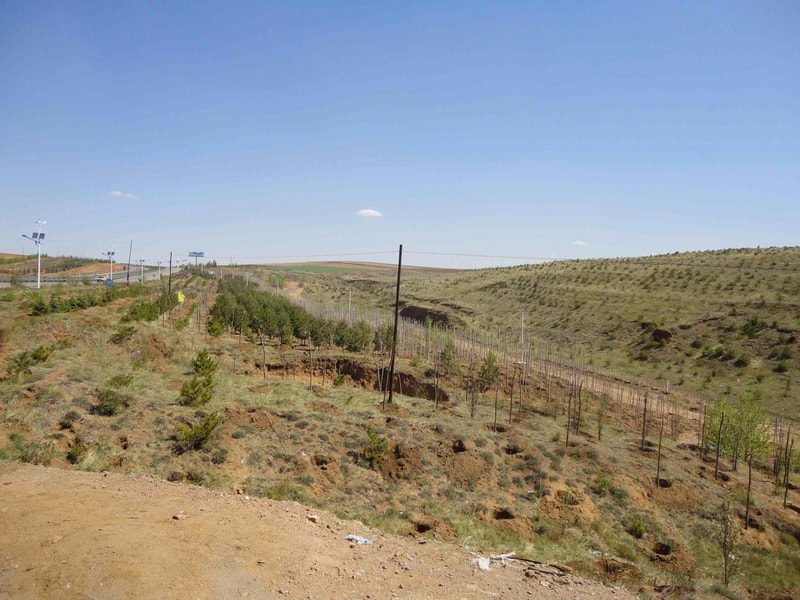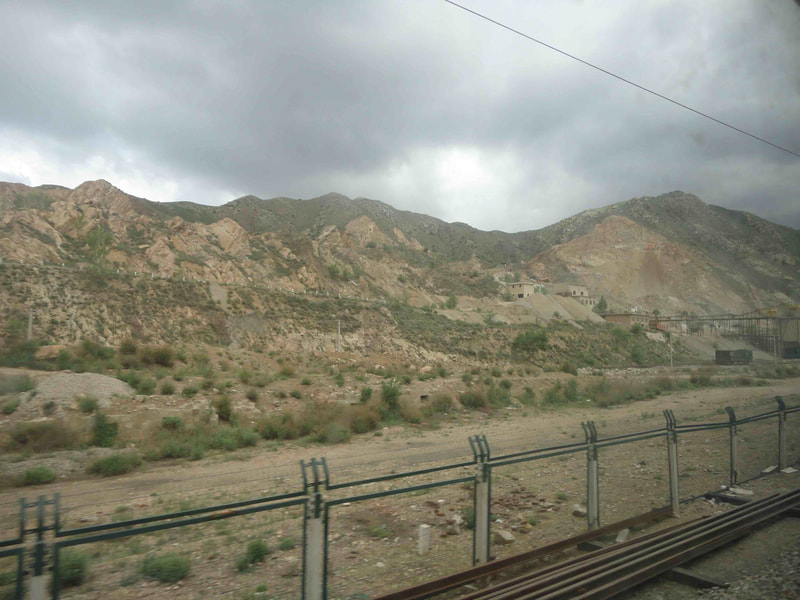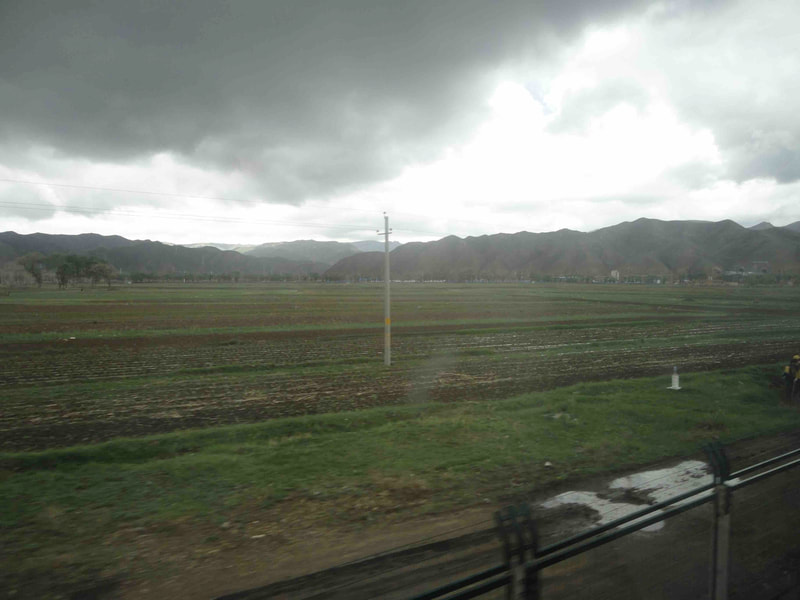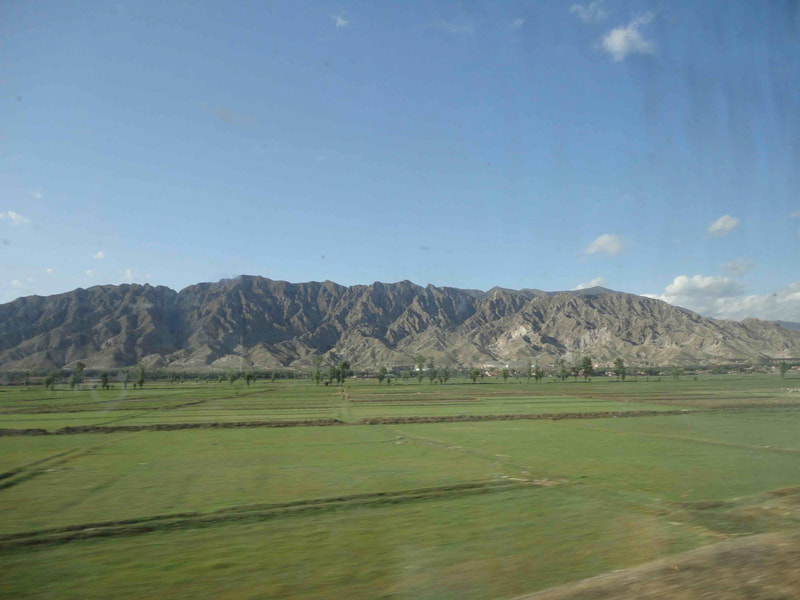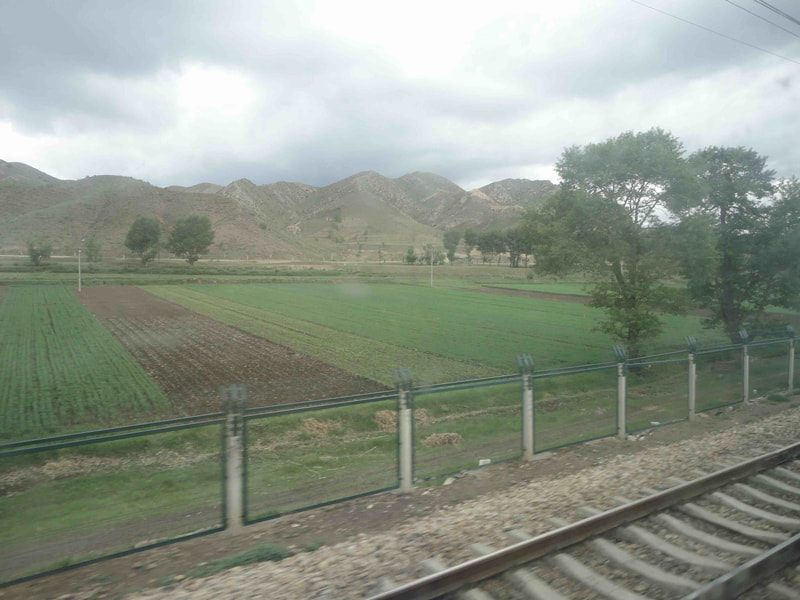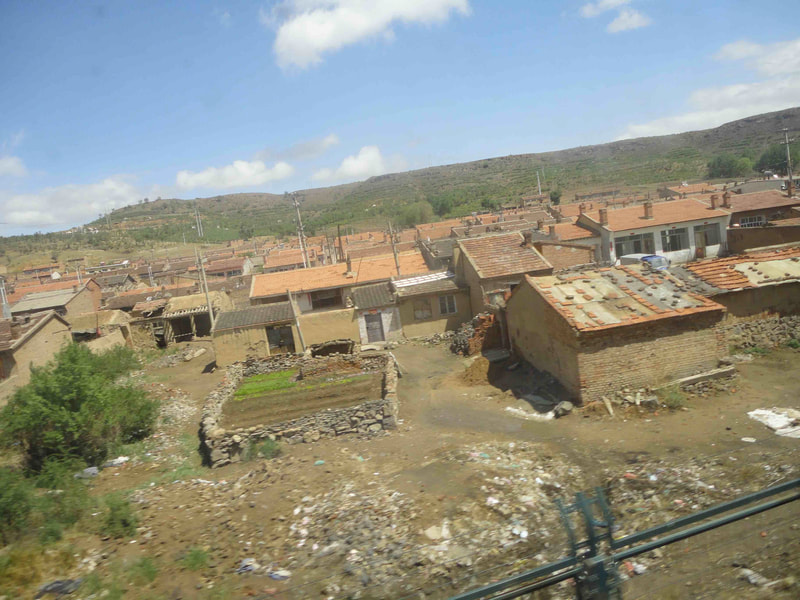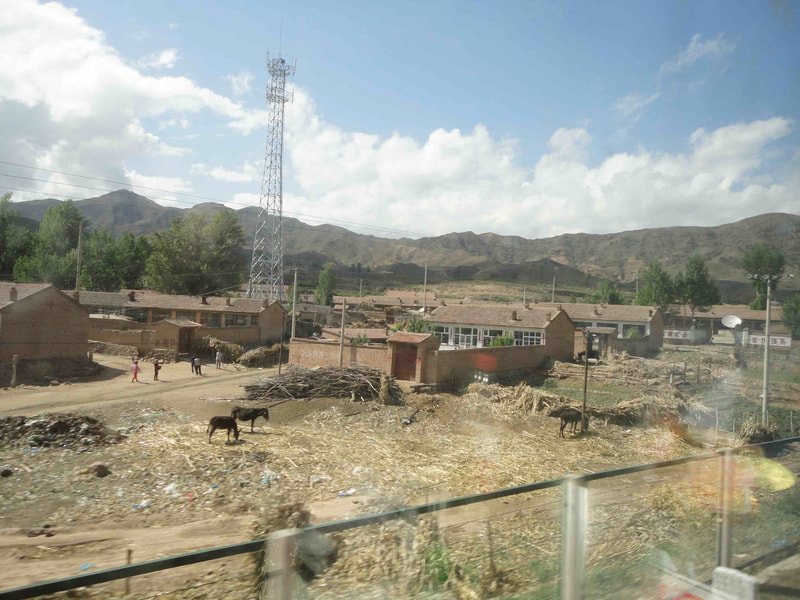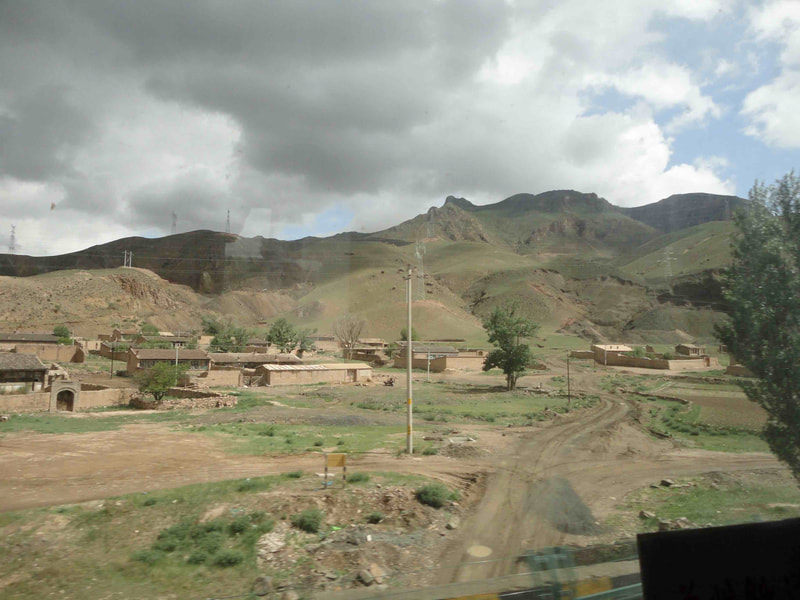Photo: Failed attempt to grow trees on the Loess Plateau, Yellow River, China, 2007. © 2007 Delena Norris-Tull
China: Agricultural Practices Past and Present
I have had the amazing opportunity to visit, and travel expensively, within China. In 2007, 2009, and again in 2012, I spent a full month on each trip, traveling across the country by train and plane, visiting various friends, making new friends, and providing professional development to teachers in various schools. Other countries, such as India, also have major problems related to soil loss. But I will use China as an example of the results of decades of poor management of agricultural lands, as it serves as a cautionary tale for the rest of the world, including the USA.
In 2018, 564 million (40%) of the 1.3 billon Chinese lived in rural areas (Statista.com). Only 10% of the land in China is arable (able to be cultivated), most of that in the eastern provinces. China and the continental USA are roughly the same size. In the USA, 20% of the land in the continental States is arable, and we have one billion fewer people.
I was able to observe many rural areas during my travels. During my first visit to China in 2007, I had the incredible opportunity to travel by train from Xian to Lhasa, Tibet. During that 39-hour train ride, I witnessed and photographed the extent of the damage to farming and grazing areas in northern and western China, particularly on the Loess Plateau and the Tibetan Plateau. The Loess Plateau is an area that covers 640,000 square kilometers across seven provinces in northern and western China. The plateau was created by windblown soil that is hundreds of meters thick in many areas. It is a powdery, highly erodible soil. The Yellow River flows through much of the plateau. The river gets its name from the silt that it carries across the plateau.
The damages to the land that I observed during my train rides were largely the result of improper agricultural practices forced on the rural populace by Chairman Mao Zedong’s single-minded attempts in the 1950s to become a world exporter of wheat, other grains, and steel.
Prior to the Communist takeover of China, many areas of China were covered with forests and grasslands, and, in addition to farming, many people raised sheep and goats and planted orchards. As a result of the policies of Mao Zedong, massive tree cutting occurred in the 1950s, as rural residents were required to destroy orchards and forests to grow grains, and to keep a large backyard furnace going at all times, to melt metals (including pots and pans) to make steel (Becker, 2000, p. 35). Many trees were cut to build terraces to grow more grains. Planting crops on steep terraces caused massive erosion. Due to these policies, thousands of years of agricultural knowledge were ignored, and massive amounts of soil eroded away.
84,000 dams were built during the Mao era (earthen dams, many of which were destroyed in large floods from 1973 to 1977). Huge human and financial resources were expended to complete these projects. One-third of the 10 million rural residents who were displaced to make way for the dams still live in abject poverty today, and one-third more live at mere subsistence levels. One dam that broke in 1975 killed an estimated 85,000 people.
The agricultural policies of the 1950s combined to cause the greatest famine in Chinese history, which resulted in an estimated 38-45 million people dying of starvation between 1958-1962. Extensive damage was caused to the Loess Plateau. Riverbeds dried up, and hills became barren. Periods of drought increased.
Today, water is so scarce throughout China, that many rural residents dig holes in the ground to act as cisterns, and rely on collecting rain water for agriculture and living (Becker, 2000, p. 36).
After Mao Zedong’s death in 1976, Deng Xiaoping gained political power in the government by 1978. Under his leadership, the Communist Party initiated many reforms in the 1980s (Starr, 2001, p. 76). In regards to agriculture, the Party changed the way agricultural land was administered. When the Communist Party took over the rule of China in 1949, almost all agricultural land was converted to either ownership by the state or by collectives, later called people’s communes. A collective is a large group of people who have local ownership and management of the land. However, after Deng’s reforms, revisions to the collectives enabled them to lease the land to households, who had a contract that designated how much grain or other product had to be produced, and how much would be given back to the state. Eventually, the collectives evolved into economic cooperatives. While the household contracts gave households some ability to decide what to grow, and the ability to sell any surplus product, the system does not give households much incentive to conserve water or soil, thus it contributes to further environmental degradation. Also, lack of education often results in overuse and inappropriate use of pesticides and herbicides.
Although China is the world’s leader in the use of renewable energy, coal still provides 66% of energy consumption (Sastry, 2020). In the countryside, farm communities rely heavily on trees and plant stalks for cooking and heating. This has led to additional problems with deforestation. In recent decades, more than 300 million acres have been deforested. This has led to the desertification of about 16 million acres (Starr, 2001, p. 177). This has resulted in major dust storms that carry silt across China. I experienced these dust storms while visiting Beijing.
Today, there is still a belief that terraces and dams are effective means of increasing agricultural production. However, terraces are now forbidden on slopes with greater than a 25 degree gradient. New efforts are in place to plant grass, bushes, and trees to stabilize the soil (Becker, 2000, p. 36). While in the more fertile areas of China, farmers have been able to purchase mechanized farm equipment, 90% of harvesting is still done manually and 80% of sowing is manual. My train rides across the drought-prone areas of northern and western China revealed very little mechanized farming.
Rural residents supposedly can lease land that is returned to forestry, and to use the new pasture to raise sheep and goats (Becker, 2000, p. 37). But so far, very little land has actually been restored to such use.
In 1997, the Yellow River ran dry for 9 months of the year, 600 miles before reaching the sea. The aquifer under the river is dropping at the rate of 4 feet per year (Becker, 2000, p. 38).
So much of the land is now unusable, that the government plans to relocate millions of people living in the poorest regions. The relocation is contingent on the building of hundreds of earthen dams along the Yellow River, in order to provide enough irrigation water to create farmable land for the displaced people to live on.
In 1995, the Loess Plateau Watershed Rehabilitation Project was initiated. With the assistance of the World Bank, Chinese scientists have worked closely with international agro-scientists, to attempt to restore the plateau. The plan that was developed incorporates the following strategies: Ban tree cutting; ban planting crops on steep slopes; ban free-range livestock grazing; create clear policies to guide farmers assigned to take care of each section of land; designate distinctions between ecological and economic land, to enable marginal lands to return to natural vegetative cover; integrate watershed management practices, including agro-foresty methods, reforestation, and grasslands regeneration.
However, twelve years later, what I witnessed in 2007 was mass wasting of hillside terraces on the Loess Plateau, unsuccessful attempts to re-plant trees, the dried-up basin of the Yellow River, and silted lakes on the Tibetan Plateau. The erosion on the hillsides had forced farmers to plant their crops in the dry river bottoms.
References:
Next Sections:
Photo Gallery: Trips across China, views of agricultural lands:
2007: Xi'an to Lhasa, from the Loess Plateau and the Yellow River, to the Tibetan Plateau
2012: Bus trip to northern Inner Mongolia; Train from Hohhot to Beijing. All photos by Delena Norris-Tull
China: Agricultural Practices Past and Present
I have had the amazing opportunity to visit, and travel expensively, within China. In 2007, 2009, and again in 2012, I spent a full month on each trip, traveling across the country by train and plane, visiting various friends, making new friends, and providing professional development to teachers in various schools. Other countries, such as India, also have major problems related to soil loss. But I will use China as an example of the results of decades of poor management of agricultural lands, as it serves as a cautionary tale for the rest of the world, including the USA.
In 2018, 564 million (40%) of the 1.3 billon Chinese lived in rural areas (Statista.com). Only 10% of the land in China is arable (able to be cultivated), most of that in the eastern provinces. China and the continental USA are roughly the same size. In the USA, 20% of the land in the continental States is arable, and we have one billion fewer people.
I was able to observe many rural areas during my travels. During my first visit to China in 2007, I had the incredible opportunity to travel by train from Xian to Lhasa, Tibet. During that 39-hour train ride, I witnessed and photographed the extent of the damage to farming and grazing areas in northern and western China, particularly on the Loess Plateau and the Tibetan Plateau. The Loess Plateau is an area that covers 640,000 square kilometers across seven provinces in northern and western China. The plateau was created by windblown soil that is hundreds of meters thick in many areas. It is a powdery, highly erodible soil. The Yellow River flows through much of the plateau. The river gets its name from the silt that it carries across the plateau.
The damages to the land that I observed during my train rides were largely the result of improper agricultural practices forced on the rural populace by Chairman Mao Zedong’s single-minded attempts in the 1950s to become a world exporter of wheat, other grains, and steel.
Prior to the Communist takeover of China, many areas of China were covered with forests and grasslands, and, in addition to farming, many people raised sheep and goats and planted orchards. As a result of the policies of Mao Zedong, massive tree cutting occurred in the 1950s, as rural residents were required to destroy orchards and forests to grow grains, and to keep a large backyard furnace going at all times, to melt metals (including pots and pans) to make steel (Becker, 2000, p. 35). Many trees were cut to build terraces to grow more grains. Planting crops on steep terraces caused massive erosion. Due to these policies, thousands of years of agricultural knowledge were ignored, and massive amounts of soil eroded away.
84,000 dams were built during the Mao era (earthen dams, many of which were destroyed in large floods from 1973 to 1977). Huge human and financial resources were expended to complete these projects. One-third of the 10 million rural residents who were displaced to make way for the dams still live in abject poverty today, and one-third more live at mere subsistence levels. One dam that broke in 1975 killed an estimated 85,000 people.
The agricultural policies of the 1950s combined to cause the greatest famine in Chinese history, which resulted in an estimated 38-45 million people dying of starvation between 1958-1962. Extensive damage was caused to the Loess Plateau. Riverbeds dried up, and hills became barren. Periods of drought increased.
Today, water is so scarce throughout China, that many rural residents dig holes in the ground to act as cisterns, and rely on collecting rain water for agriculture and living (Becker, 2000, p. 36).
After Mao Zedong’s death in 1976, Deng Xiaoping gained political power in the government by 1978. Under his leadership, the Communist Party initiated many reforms in the 1980s (Starr, 2001, p. 76). In regards to agriculture, the Party changed the way agricultural land was administered. When the Communist Party took over the rule of China in 1949, almost all agricultural land was converted to either ownership by the state or by collectives, later called people’s communes. A collective is a large group of people who have local ownership and management of the land. However, after Deng’s reforms, revisions to the collectives enabled them to lease the land to households, who had a contract that designated how much grain or other product had to be produced, and how much would be given back to the state. Eventually, the collectives evolved into economic cooperatives. While the household contracts gave households some ability to decide what to grow, and the ability to sell any surplus product, the system does not give households much incentive to conserve water or soil, thus it contributes to further environmental degradation. Also, lack of education often results in overuse and inappropriate use of pesticides and herbicides.
Although China is the world’s leader in the use of renewable energy, coal still provides 66% of energy consumption (Sastry, 2020). In the countryside, farm communities rely heavily on trees and plant stalks for cooking and heating. This has led to additional problems with deforestation. In recent decades, more than 300 million acres have been deforested. This has led to the desertification of about 16 million acres (Starr, 2001, p. 177). This has resulted in major dust storms that carry silt across China. I experienced these dust storms while visiting Beijing.
Today, there is still a belief that terraces and dams are effective means of increasing agricultural production. However, terraces are now forbidden on slopes with greater than a 25 degree gradient. New efforts are in place to plant grass, bushes, and trees to stabilize the soil (Becker, 2000, p. 36). While in the more fertile areas of China, farmers have been able to purchase mechanized farm equipment, 90% of harvesting is still done manually and 80% of sowing is manual. My train rides across the drought-prone areas of northern and western China revealed very little mechanized farming.
Rural residents supposedly can lease land that is returned to forestry, and to use the new pasture to raise sheep and goats (Becker, 2000, p. 37). But so far, very little land has actually been restored to such use.
In 1997, the Yellow River ran dry for 9 months of the year, 600 miles before reaching the sea. The aquifer under the river is dropping at the rate of 4 feet per year (Becker, 2000, p. 38).
So much of the land is now unusable, that the government plans to relocate millions of people living in the poorest regions. The relocation is contingent on the building of hundreds of earthen dams along the Yellow River, in order to provide enough irrigation water to create farmable land for the displaced people to live on.
In 1995, the Loess Plateau Watershed Rehabilitation Project was initiated. With the assistance of the World Bank, Chinese scientists have worked closely with international agro-scientists, to attempt to restore the plateau. The plan that was developed incorporates the following strategies: Ban tree cutting; ban planting crops on steep slopes; ban free-range livestock grazing; create clear policies to guide farmers assigned to take care of each section of land; designate distinctions between ecological and economic land, to enable marginal lands to return to natural vegetative cover; integrate watershed management practices, including agro-foresty methods, reforestation, and grasslands regeneration.
However, twelve years later, what I witnessed in 2007 was mass wasting of hillside terraces on the Loess Plateau, unsuccessful attempts to re-plant trees, the dried-up basin of the Yellow River, and silted lakes on the Tibetan Plateau. The erosion on the hillsides had forced farmers to plant their crops in the dry river bottoms.
References:
- Becker, J. (2000). The Chinese. New York: Oxford University Press.
- Sastry, S.V.A.R. (August, 2020). Changes in energy consumption patterns: A case study of India and China. Annals of Faculty Engineering Hunedoara: International Journal of Engineering, XVIII (3):163-170.
- Starr, J.B. (2001). Understanding China. New York: Hill & Wang.
Next Sections:
- UN Biodiversity Report
- Policy vs. Practice
- Ecosystems & Economics
- Why we need plants
- Invasive Success Hypotheses
Photo Gallery: Trips across China, views of agricultural lands:
2007: Xi'an to Lhasa, from the Loess Plateau and the Yellow River, to the Tibetan Plateau
2012: Bus trip to northern Inner Mongolia; Train from Hohhot to Beijing. All photos by Delena Norris-Tull
